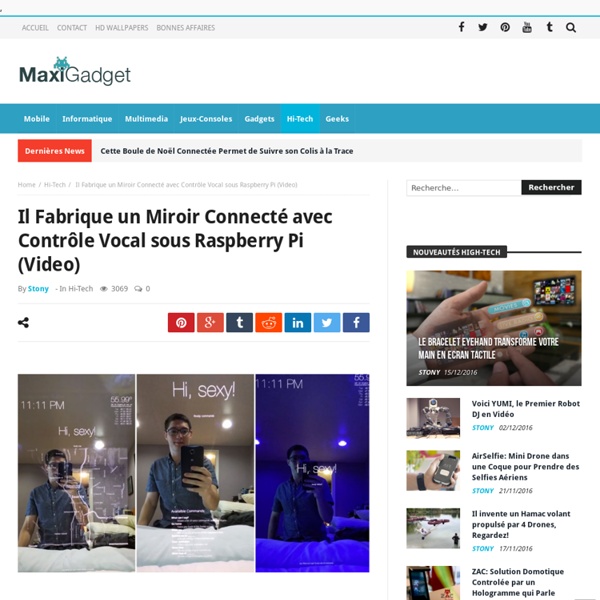Touch Screen coffee table DIY with 32" TV and low cost CCD sensor - 3
As Wikipedia is way better than me on explaining : "A charge-coupled device (CCD) is a device for the movement of electrical charge, usually from within the device to an area where the charge can be manipulated, for example conversion into a digital value. This is achieved by "shifting" the signals between stages within the device one at a time. The CCD is a major piece of technology in digital imaging. Basically, the CCD you find in a scanner doesn't read lights in two dimensions, but on one line. As I couldn't find any tutorials explaining how they work on the internet, I tried to understand the logic by myself. By visually checking all the lines going from the control board to the CCD you can try to identify the 4 lines controlling the RGB LED, they are generally located at the extremity of the CCD board. I tried two CCD sensors from different brands and they where both using the same communication protocol but not on the same "line order on the flex".
Light, Fan, and Dimmer Control With ESP8266 and Cayenne
The previous owner of my house installed remote controlled ceiling lights in all the bedrooms. This was really cool for a couple weeks, but now I’m realizing that it can be really annoying when I misplace the remote. Each room has a separate remote that only works for that room. Extra remotes are both expensive and hard to come by. Making my own rf remote is impractical as they run in the 400mhz range and there is generally very little documentation about the radio codes for this fan model. To circumvent this, I disassembled one remote and soldered transistors directly to the physical button contacts.
Introduction · Smart Mirror Documentation
Arduino Nano: HMC5883 Compass With Visuino
HMC5883L are popular Compass sensors. They can be used for navigation systems, drones, and robots. In this Instructable, I will show you, how easy it is to program Arduino to use HMC5883L Compass, with Visuino - an easy to use graphical development environment for Arduino. Please note that the annotation on some of the pictures in this Instructable will work correctly on some browsers only after you click on the image to expand it. Please make sure you click on the image to see the annotation showing the correct spot on the image!
evancohen/smart-mirror: The fairest of them all
relayr for Developers | relayr
We support a variety of platforms for creating your IoT project. Whether you create your own hardware and connect it to the relayr cloud, or make use of our own connected out of the box sensors, relayr is the simplest way to realize your IoT dreams. You can start programming in: Why WunderBar? Get Started Immediately There’s never been a faster way to enter into the world of the Internet of Things. Work With What You Know Software Developers: The WunderBar’s sensors are pre-integrated and pre-programmed – there’s no need for tricky soldering, wiring or firmware debugging. Hardware Developers: Connect your projects to the cloud and apps with the WunderBar Bridge Module’s serial port. Your Imagination is the Limit WunderBar comes with enough hardware to realize your ideas, whatever they are. Any other sensors you’d like can be easily connected to the cloud and your apps through the WunderBar Bridge Module. Open Source Through and Through We’ve open sourced the WunderBar’s hardware and firmware.
MichMich/MagicMirror: MagicMirror²
HomeKit and Particle Photon - Particle Projects
Introduction After viewing this great example by Nikita Leonov, I decided to work on HomeKit and Particle Photon. I decided to simulate Temperature, Humidity and Luminosity sensor and one Light. Here is the sample I completed. Here in this sample, I am using Homebridge and HAP-NodeJS to emulate HomeKit API. Homebridge supports 2 types of shims, accessory and platforms. DHT22 sensor is used to read Temperature and Humidity, TSL2561 sensor is used for luminosity. The Particle Accessory listens for this events and whenever it is received, update the Characteristics. Wiring DHT22 Vcc to Photon 3.3v DHT22 GND to Photon GND DHT22 Data to Photon D4TSL2561 3.3vto Photon 3.3vTSL2561 GND to Photon GNDTSL2561 SDA to Photon D0TSL2561 SCL to Photon D1RGB Led R to Photon A4RGB Led G to Photon A5RGB Led B to Photon A7RGB Led GND to Photon GND How to run Screenshots Demo Video Controlling a Light using HomeKit application Using Siri to control light
6 Best Raspberry Pi Smart Mirror Projects We've Seen So Far
The magic mirror of the future won’t just say you’re the prettiest of them all. It’ll also tell you the time, date, weather outside, upcoming calendar appointments, and more. In fact, you can make such a smart mirror right now. All you need is a Raspberry Pi and some DIY work. A smart mirror is featured on one of these amazing videos to peek into the future. Why You Need a Raspberry Pi A smart mirror is basically a mirror with a screen behind it. The Pi is basically a credit card-sized computer. At the moment, no one has made a smart mirror with the $5 Raspberry Pi Zero. What You’ll Need Whichever smart mirror project you decide to do from this list, there are a few elements you’ll always need. A Two-Way Mirror It’s a smart mirror, so it should be no surprise that you actually need a mirror, right? An LCD Monitor This is the best way to make use of any old computer monitor you have lying around. A Raspberry Pi So far, no one has made a smart mirror with the $5 Pi Zero. A Wooden Frame
pebble/pebblejs



